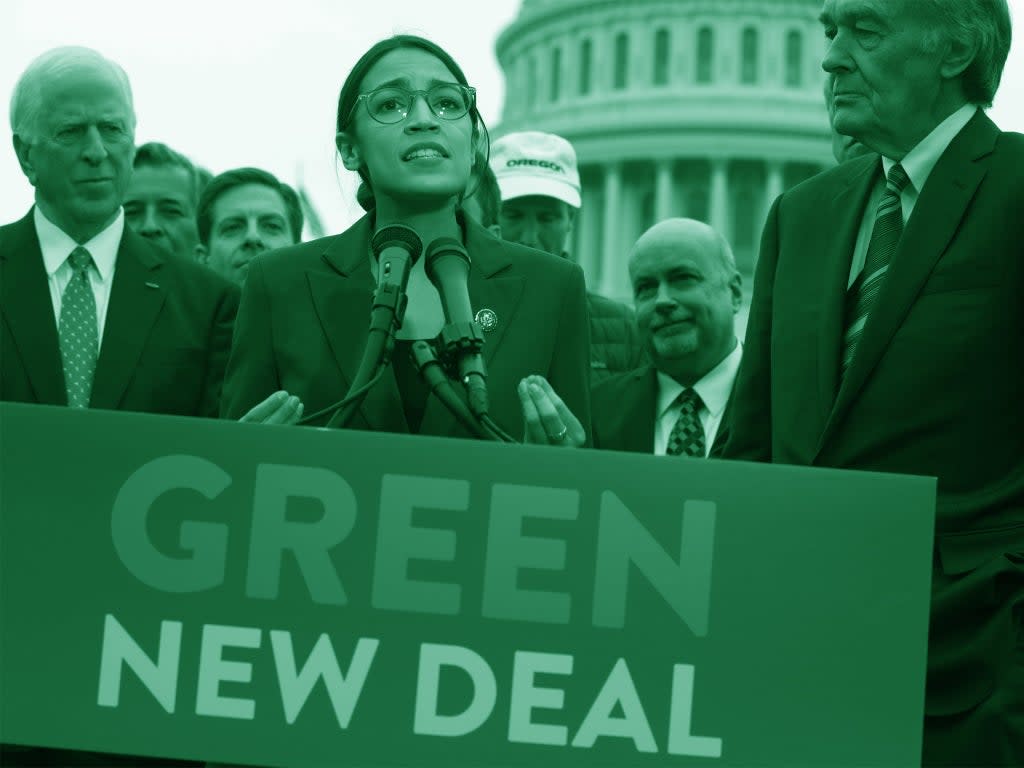What is the Green New Deal and how does Biden’s climate plan compare?

Just weeks after the 2020 US election, Alexandria Ocasio-Cortez and other progressive members of “the squad” rallied outside the Democratic National Committee headquarters demanding Joe Biden embrace the Green New Deal.
“We are all here today because of the movement ... because at the end of the day, dollars don’t vote, people do,” Representative Ocasio-Cortez said at the rally on 20 November 2020.
During the election campaign, President Biden said that he would not pursue a Green New Deal, and instead laid out his own $2 trillion plan for addressing the climate crisis.
But the president’s plan drew criticism from the progressive wing of the Democratic Party who said the proposals did not go far enough.
So what exactly is the Green New Deal? And how does President Biden’s plan to tackle the climate crisis compare?
Read More
World’s largest carbon-sucking factory starts operation in Iceland
‘The climate crisis is a reality’: Africa’s summer of extremes
Against the odds: The fight to save sea turtles in Ras Baridi
What is the Green New Deal?
Inspired by President Franklin D Roosevelt’s vast public works programmes that helped America recover from the Great Depression in the 1930s, the Green New Deal seeks to fight the climate crisis and tackle inequality simultaneously.
Like FDR’s New Deal, the Green New Deal is not a single project or piece of legislation. Instead it outlines the broad principles of a plan to achieve net-zero greenhouse gas emissions across the US economy by 2030.
It also aims to guarantee new high-paying jobs in clean energy industries and ensure that vulnerable groups including “indigenous peoples, communities of color, migrant communities, de-industrialized communities” benefit from the green economy.
Who supports the Green New Deal?
The basic principles of the Green New Deal were devised more than 10 years ago by a group of academics and activists in response to the 2008 financial crash.
A decade later, Democratic politicians Alexandria Ocasio-Cortez and Ed Markey revived the idea and introduced a Green New Deal resolution in Congress in 2019.
While the Senate defeated a motion to take up the Green New Deal in March 2019, the proposal has become an animating force in politics and forced a discussion on the climate crisis.
The majority of Democratic presidential candidates in the 2020 race co-sponsored or endorsed the Green New Deal resolution.
But while President Joe Biden’s campaign platform described the Green New Deal as a “crucial framework”, it didn’t go as far as the ambitious proposal that calls for achieving net-zero greenhouse gas emissions across the economy by 2030.
Republicans dismissed the Green New Deal as an expensive “socialist manifesto”. Utah congressman Rob Bishop even described the proposal as “tantamount to genocide” for rural America.
However, opinion polling in the US shows levels of concern over climate issues have never been higher.
A poll shared exclusively with The Independent found that almost half of Americans want to transition from fossil fuels. The survey of 5,500 people across the US last month also found that the majority of Americans agree time is running out to save planet.
How would the Green New Deal work?
The resolution calls for the launch of a “10-year national mobilization” to reduce carbon emissions in the US.
It envisions:
- Sourcing 100 per cent of the country’s electricity from renewable and zero-emissions power
- Building or upgrading to “smart” power grids
- Overhauling infrastructure with electric vehicles and public transport including high-speed rail
- Upgrading all existing buildings to achieve maximum energy efficiency
- Building resiliency against climate change-related disasters
- Restoring forests to remove greenhouse gases from the atmosphere
- Working with farmers to cut emissions from the agricultural sector
The Green New Deal also seeks to address social inequality and proposes strengthening the right of workers to organise and unionize. It calls for all Americans to be provided with high-quality healthcare, affordable and safe housing as well as clean water and air.
In its current form, the Green New Deal is a non-binding resolution and the costs of the project are unclear.
Rep. Ocasio-Cortez said it would cost at least $10 trillion, while Donald Trump put the figure at $100 trillion.
The amount the president cited is rounded up from an estimate by the conservative think tank American Action Forum, which said it could cost between $51 trillion and $93 trillion.
But supporters of the Green New Deal say the climate crisis could be equally or more costly to the US economy.
How does Joe Biden’s climate change plan compare?
Mr Biden's climate plan is the boldest of any US president in history, but it doesn’t go as far as the ambitious proposals of the Green New Deal.
While the Green New Deal proposes achieving net-zero greenhouse gas emissions across the economy by 2030, Mr Biden aims to reach this milestone by 2050.
He has also repeatedly pledged not to abolish fracking, a set of techniques for recovering oil and gas from shale rock.
The president tread carefully around the issue during his election campaign as the fracking industry provides thousands of jobs in key battleground state, Pennsylvania.
Among Mr Biden’s climate change proposals is a $2 trillion investment in clean energy to create carbon-free electricity by 2035.
He also plans to improve energy efficiency in buildings and housing, and promote the production of electric vehicles and conservation efforts in the agriculture industry.
The climate plan includes a requirement that 40 per cent of the money spent on clean energy deployment, reduction of legacy pollution and other investments go to historically disadvantaged communities.
Mr Biden also rejoined the 2015 Paris Climate Agreement on the first day of his presidency, the international pact to limit global heating to well below 2C.

 Yahoo News
Yahoo News 
